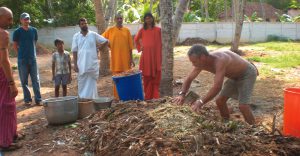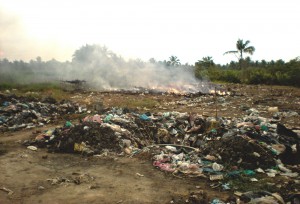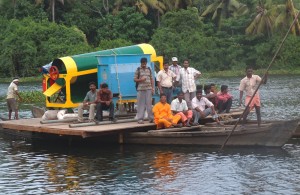Low tech composting operations are being installed on ashram campuses to mitigate pollution and provide a high value soil amendment for gardens and agriculture.
Peter Ash
BioCycle July 2012, Vol. 53, No. 7, p. 26

The author builds the first compost pile at the ashram in Kerala using shavings from the wood shop. Small piles were built daily.
Tools, including pitchforks and western-style shovels, were fabricated in the ashram’s metal shop. The first compost pile was constructed in mid-May. Small piles were built daily with the incoming food waste. In anticipation of the approaching monsoon, a simple roof was constructed and the piles were consolidated to save space. By early July, the first batch of finished compost was used in the ashram’s gardens and landscape. Eventually, compost also was taken to the ashram’s farms.
Hospital Project

Waste from a 1,200 bed hospital and medical research facility in Cochin was being boated across the backwaters to an island and openly dumped or burned. This site was selected for the composting operation.
Several pieces of property were assessed for the composting operation. The island dump site was the best choice (and subsequently was renamed “Compost Island”). Diagrams were sketched in the sand of what was needed — a roof for the windrow operation and a system of “open tanks” for vermicomposting. Construction began immediately in February 2010. All open burning was halted as site clean up began. All noncompostable items were returned to the mainland for recycling or proper incineration.
AIMS produces about 4 tons/day of food waste. The waste audit reveled another 4.5 tons of yard trimmings, wood shavings, animal manures and soiled paper. A sorting and mixing table was set up to remove noncompostables before composting. While waiting for the roof construction, composting began in open windrows in March 2010. Knowing that larger equipment would be needed, a small farm tractor was purchased and a pull-behind windrow turner was fabricated in the machine shop. The tractor and turner were then boated over to the island by lashing two large wooden canoes together and poling them across the backwaters.
On a trip looking for equipment, we were asked to visit the ashram’s Ettimadai university campus in Tamil Nadu to evaluate food waste composting there. Ettimadai was composting yard debris and tree trimmings in static piles, but the materials were taking a year to decompose. The next day we began mixing food waste (1.5 tons/day are generated) with dried leaves and grasses. The lack of shredding created matting and restricted air flow. Eventually, a small agricultural shredder was purchased. Shredding the coconuts, sticks and dried leaves yielded a better particle size and improved air flow.
Mechanical engineering students at Ettimadai fabricated a turner and trommel screen for their site. Working with the manufacturer, some modifications were made to the shredder to handle wet items like banana stems, fresh coconuts and pineapple tops. Ettimadai built a trommel screen and this new equipment was sent to AIMS and boated over to the island.

Two lashed-together canoes and a makeshift platform transport a trommel screen built by an ashram’s engineering college to “Compost Island.”
Vermicomposting Water Weeds
One difficulty in boating feedstocks to “Compost Island” is the seasonal bloom of water hyacinth. This invasive water weed clogs the water ways, preventing local fishermen from their livelihood. Research identified several studies conducted in India on vermicomposting water hyacinth with cow dung. After a 30-day fermentation period the mixed material was fed to worms. In another 40 days, the vermicompost was ready. Based on this research, we began clearing the water weed from the backwaters and expanded AIMS vermicomposting using the African night crawler, Eudrillues eugeniae. This operation is leading to vocational training programs for local self-help groups.
These projects, with participation by the universities, are a model of resource management for all of India. A compost operations manual is being written and will be made available to other institutions and municipalities. Next on the horizon is setting up the Zero Waste model in one of the ashram’s elementary schools. Students will learn recycling, composting and vermicomposting, and gardening. Compost will be used in school gardens where food production becomes part of the school lunch program.
Peter Ash, an organic farmer, Master Composter, permaculture designer, and trained naturalist, owns and operates Straight Ash Environmental Solutions, which consults internationally on environmental projects, sustainable food systems and ecosystem restoration. He is based in San Diego County, California. www.straightash.com.










